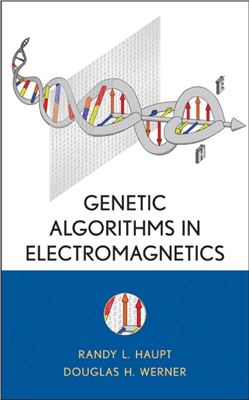Wiley-IEEE Press, 2007, pages: 297
A thorough and insightful introduction to using genetic algorithms to optimize electromagnetic systems. Genetic Algorithms in Electromagnetics focuses on optimizing the objective function when a computer algorithm, analytical model, or experimental result describes the performance of an electromagnetic system. It offers expert guidance to optimizing electromagnetic systems using genetic algorithms (GA), which have proven to be tenacious in finding optimal results where traditional techniques fail.
This book begins with an introduction to optimization and some of the commonly used numerical optimization routines. Chapter 1 provides the motivation for the need for a more powerful global optimization algorithm in contrast to the many local optimizers that are prevalent. The next chapter introduces the GA to the reader in both binary and continuous variable forms. MATLAB® commands are given as examples. Chapter 3 provides two stepby- step examples of optimizing antenna arrays. This chapter serves as an excellent introduction to the following chapter, on optimizing antenna arrays. GAs have been applied to the optimization of antenna arrays more than has any other electromagnetics topic. Chapter 5 somewhat follows Chapter 4, because it reports the use of a GA as an adaptive algorithm. Adaptive and smart arrays are the primary focal points, but adaptive refl ectors and crossed dipoles are also presented. Chapter 6 explains the optimization of several different wire antennas, starting with the famous crooked monopole. Chapter 7 is a review of the results for ho, refl ector, and microstip patch antennas. Optimization of these antennas entails computing power signifi cantly greater than that xii PREFACE required for wire antennas. Chapter 8 diverges from antennas to present results on GA optimization of scattering. Results include scattering from frequency-selective surfaces and electromagnetic bandgap materials. Finally, chapter 9 presents ideas on operator and parameter selection for a GA. In
addition, particle swarm optimization and multiple objective optimization are explained in detail. The Appendix contains some MATLAB® code for those who want to try it, followed by a chronological list of publications grouped by topic.
A thorough and insightful introduction to using genetic algorithms to optimize electromagnetic systems. Genetic Algorithms in Electromagnetics focuses on optimizing the objective function when a computer algorithm, analytical model, or experimental result describes the performance of an electromagnetic system. It offers expert guidance to optimizing electromagnetic systems using genetic algorithms (GA), which have proven to be tenacious in finding optimal results where traditional techniques fail.
This book begins with an introduction to optimization and some of the commonly used numerical optimization routines. Chapter 1 provides the motivation for the need for a more powerful global optimization algorithm in contrast to the many local optimizers that are prevalent. The next chapter introduces the GA to the reader in both binary and continuous variable forms. MATLAB® commands are given as examples. Chapter 3 provides two stepby- step examples of optimizing antenna arrays. This chapter serves as an excellent introduction to the following chapter, on optimizing antenna arrays. GAs have been applied to the optimization of antenna arrays more than has any other electromagnetics topic. Chapter 5 somewhat follows Chapter 4, because it reports the use of a GA as an adaptive algorithm. Adaptive and smart arrays are the primary focal points, but adaptive refl ectors and crossed dipoles are also presented. Chapter 6 explains the optimization of several different wire antennas, starting with the famous crooked monopole. Chapter 7 is a review of the results for ho, refl ector, and microstip patch antennas. Optimization of these antennas entails computing power signifi cantly greater than that xii PREFACE required for wire antennas. Chapter 8 diverges from antennas to present results on GA optimization of scattering. Results include scattering from frequency-selective surfaces and electromagnetic bandgap materials. Finally, chapter 9 presents ideas on operator and parameter selection for a GA. In
addition, particle swarm optimization and multiple objective optimization are explained in detail. The Appendix contains some MATLAB® code for those who want to try it, followed by a chronological list of publications grouped by topic.

